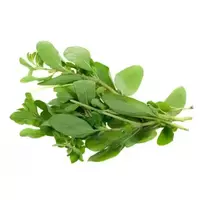Marjoram

The perennial plant marjoram belongs to the genus Dushits and is part of the Yasnotkovy family. Majorán has several other names, such as mardakush or bardakush, which are still used in countries in the Middle East region. The marjoram plant is distributed in Central Europe, as well as in the East and in the North African region.
The appearance of the marjoram resembles the closest relatives of the plant from the genus Dusitz. A low bush with erect stems, oblong small green leaves, as well as white inflorescences and a fruit box with nut-like contents. The beneficial properties of marjoram are determined by the chemical composition of the plant, which contains a large amount of essential oils.
The chemical composition of marjoram includes such substances useful for the human body as rutin, ascorbic acid, as well as carotene. In addition, the useful properties of marjoram consist in the content of a large amount of tannins, as well as pectin substances of natural origin. The essential oil of marjoram has a pronounced smell, which is somewhat similar to the aroma of cardamom or thyme.
However, marjoram is distinguished by a more subtle sweet aroma, as well as a slightly sharp and spicy taste. Until now, scientists and researchers cannot accurately determine the composition of the essential oil of marjoram. The fact is that science still does not know exactly what substance gives the plant its distinctive and extremely persistent spicy aroma.
Dried marjoram is often used in cooking, but fresh leaves of the plant are added to some dishes. In the Middle East region, marjoram seasoning is considered a must-have ingredient in most national cuisine. Moreover, it is customary to mix marjoram with sesame seeds and add a little salt to such seasoning. It is noteworthy that decorative wreaths were made from the leaves of the marjoram, as well as from laurels in ancient Greece and Rome, which were awarded to the winners of various competitions.
Marjoram, as a spice, is perfectly combined with the ingredients of salads, vegetables, meat and fish dishes. Soups are seasoned with spice, added to homemade sausage and meat products. Often, marjoram is part of drinks, both alcoholic (pouring) and without alcoholic (tea). The benefit of marjoram for the human body lies in the effect of active biological substances that are contained in the plant on the digestive system.
Majoran has a sedative effect. The spice is often used in medicines and in traditional medicine. Majoran helps with diseases of the gastrointestinal tract, with bronchitis, paralysis, asthma, runny nose and neurasthenia. The marjoram plant is considered an excellent aid in the prevention of colds and diseases of the respiratory tract. Majoran can be eaten fresh and dried, as well as the plant belongs to honey. Marjoram honey is one of the most delicious and healthy foods.
majorana 271 kCal
Energy value of marjoram (Ratio of proteins, fats, carbohydrates - ju):
Proteins: 12.66 g (~ 51 kCal)
Fats: 7.04 (~ 63 kCal)
Carbohydrates: 60.56 g (~ 242 kCal)
Energy ratio (b | y): 19% | 23% | 89%
 Español
Español Français
Français Português
Português Русский
Русский 简体中文
简体中文 繁體中文
繁體中文 日本語
日本語 한국어
한국어 العربية
العربية Türkçe
Türkçe Қазақ
Қазақ Deutsch
Deutsch Italiano
Italiano Українська
Українська
